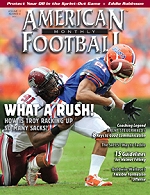Article CategoriesAFM Magazine
|
Speed Report: Why You Do What You Do for Football Speed Trainingby: Dale BaskettFootball Speed Specialist © More from this issue Have you really analyzed why you use the methods and teaching applications you use for football speed or have you just borrowed available concepts and plugged them into your program? Have you just covered the bases or have you really looked into becoming more knowledgeable about football speed? If you haven’t studied the subject, what and where did you get what you use today? Why is it good, and why did you choose to incorporate it into your football program? Did it come from a friend, a colleague, a relative, or your old coach from high school because he won a lot, or maybe it came from the internet? Is your knowledge in the speed world solid, and if so, why? You’ve put together some ideas you see others using and you assembled those into a timeframe for working on speed during the week year-round. ....The full article can only be seen by subscribers.
|
|
|||||||
| HOME |
MAGAZINE |
SUBSCRIBE | ONLINE COLUMNISTS | COACHING VIDEOS |
Copyright 2025, AmericanFootballMonthly.com
All Rights Reserved





